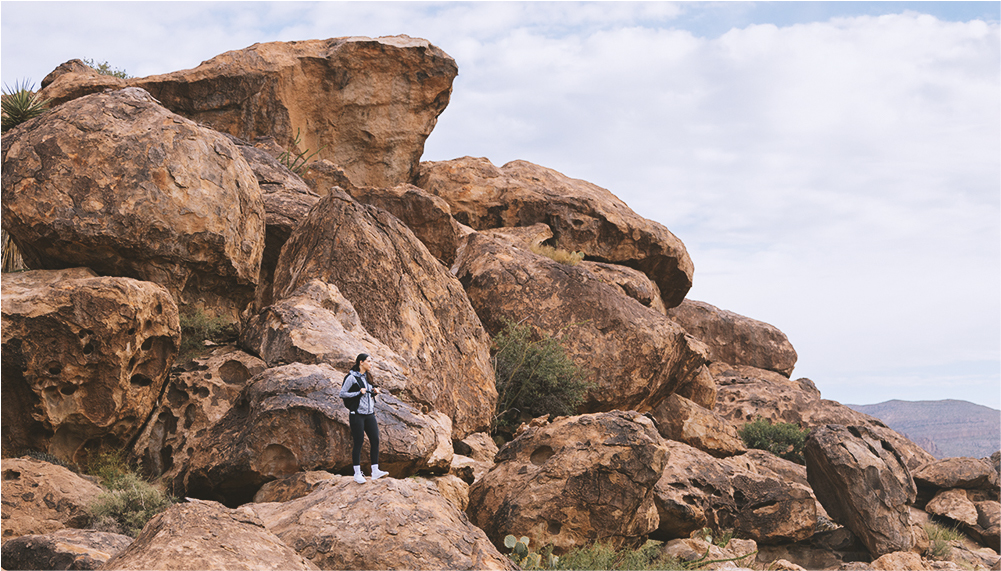



Ascend to one of the highest peaks in Texas, step inside ancient caves, admire amazing rock formations and cruise the desert in your own off-road vehicle. With nearly 300 days of sunshine a year, more than 100 miles of hiking trails and all the stark mountainous beauty of the Chihuahuan Desert, El Paso is a fantastic place to revel in the outdoors. Located in far West Texas in the foothills of the Franklin Mountains, the “Sun City” is a vibrant place full of exciting things to see and do. Discover a few of the many ways you can get outdoors in El Paso below.
Enjoy the View from the Aztec Caves
Nestled on the rugged western slope of the Franklin Mountains, the Aztec Caves are both a living piece of history and a spectacular reward at the end of a short hike. Start your journey at the trailhead of the Aztec Cave Trail in Franklin Mountains State Park, a less than 3/4-mile hike that ascends more than 400 feet past lechuguillas, ocotillos, yuccas and prickly pear cactuses. If you have hiking poles, they’ll be a big help here. Reach the end of the path and step inside the caves and you’ll notice walls stained by smoke, marks of those who came before. Savor some time in the shade as you take in the spectacular view of miles of Chihuahuan Desert terrain, a view that has delighted countless generations through the ages. For more info on Aztec Caves or the Franklin Mountains State Park click here.
Climb to the Peak of the Franklin Mountains
Standing at 7,192 feet above sea level, the imposing North Franklin Mountain is almost always in view no matter where you are in El Paso. Not only can you look upon it in admiration, you can also climb to the very top. To get there, travel up the Mundy’s Gap Trail on the eastern slopes of the mountain until you reach the North Franklin Mountain Peak Trail. Follow the path along the mountain’s eastern slope, twisting and turning over red volcanic rocks along the way. Follow the trail all the way to the summit that affords a nearly 360-degree view of El Paso, as well as New Mexico and the Mexican border. On a clear day, you may even see New Mexico’s Organ Mountains.
All told, this hike is nearly 13 miles round trip, so make sure to bring plenty of water and a sturdy pair of shoes. For more info on Mundy's Gap or the Franklin Mountains State Park click here.
Discover Ancient Native American Pictographs
Hueco Tanks State Park & Historic Site is perhaps best known as one of the best bouldering destinations in the country. Yet this area, less than 40 miles outside of El Paso, has always been a popular place to be. People of all kinds have lived and taken shelter in Hueco Tanks for more than 10,000 years, and evidence of their presence persists to this very day. Hundreds of intriguing pictographs depicting animals, deities, masks and more are easily seen, particularly if you’re on a guided tour led by a knowledgeable park ranger. Yet you can find some of them on your own as you wander through the park’s self-guided area. Walk in the footsteps of the native peoples that once called this place home and you’ll find it easy to imagine what life was like here in a different era. For additional information or to start planning your trip to Hueco Tanks click here.
Make a Day Trip to White Sands National Park
Only an hour and a half car ride away from El Paso are the glistening white gypsum dunes of White Sands National Park in New Mexico. White Sands is one of the world’s great natural wonders with its great wave-like dunes of gypsum sand that cover over 275 square miles of land. Bring along friends and family or travel solo to the national park to enjoy a thrilling day riding down the dunes, bicycling, hiking, or taking some photographs. White Sands is a one-of-a-kind outdoor experience where you can find countless opportunities for fun under the sun. Don’t forget to pack a bag with the proper equipment like sleds, sunscreen, water, snacks and other miscellaneous items to make the most out of your trip before you head back to the El Paso to call it day.
Explore the Sights of Carlsbad Caverns National Park
A mere 150 miles east of El Paso is the stunning Carlsbad Caverns National Park in the Chihuahuan Desert of southern New Mexico. With rocky slopes and canyons, more than 100 caves, and stalactites clinging to the roof of the Big Room, Carlsbad Caverns is the perfect place to explore while you’re in town visiting El Paso. When you visit the caverns, be prepared to encounter an exciting array of wildlife. Over 60 species of mammals, 17 species of bats, 357 species of birds, 55 different species of reptiles and amphibians, 5 species of fish and over 600 insects have been identified around Carlsbad Caverns.
Discover Big Bend National Park
You’ve finally made it to one of America’s most majestic outdoor playgrounds, Big Bend National Park. Now what? The possibilities really are endless. Tie on your hiking shoes and traverse more than 150 miles of trails through secluded canyons and up to mountain peaks. Mountain biking, horseback riding, and off-road vehicle tours are other ways you can explore Big Bend. Of course, we’re just getting started. Take a river trip in the shade of monumental cliffs along the Rio Grande River and see Big Bend National Park, along with Big Bend Ranch State Park, the largest state park in Texas. If it’s cold out, hike to Big Bend’s hot spring, which stays at a balmy 105 degrees year-round.
Marvel at Guadalupe National Park
Located 110 miles east of El Paso, Guadalupe Mountains National Park has been described as one of America’s best-kept secrets. Created on September 30, 1972, Guadalupe Mountains National Park preserves one of the best examples of Permian-era (260 to 270 million years ago) geology in the world. Formed from a reef in the ancient Delaware Sea, long since dry, the Guadalupe Mountains are one of the exposed sections of the 400-mile-long, horseshoe-shaped Capitán Reef, the world’s largest exposed fossil reef.
The park boasts 46,850 acres of designated wilderness, the largest wilderness area in Texas, with another 35,484 acres of backcountry that are eligible for wilderness study, and more than 80 miles of trails, about 60% of which are designated for horseback riding. Trails range from easy to strenuous, and wind through the desert, riparian, wooded and forested areas. Climb to the “Top of Texas,” 8,749 foot Guadalupe Peak, the highest point in Texas or explore the Salt Basin Dunes (the park’s lowest point at 3,689’), which contains the second largest gypsum dune field in the US, on the west side of the park, near Dell City. The park has 7 of the 10 highest peaks in Texas. Trails can be steep, rocky and rugged, so wear sturdy, closed-toe shoes or hiking boots.